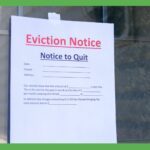You are represented at all times by one of our California Eviction Attorneys | 1-800-686-8686 | intake@fastevict.com | Se habla español
Owner Move-In Evictions in Los Angeles (RSO): 2025 Requirements, Costs, and Steps
Are you a landlord in Los Angeles navigating rent control laws and wondering how to legally recover possession of a rental unit for yourself or a family member? An owner move-in eviction (OMI) is one of the limited legal reasons you can regain possession of a rent-controlled unit. However, strict rules apply under the Los Angeles Rent Stabilization Ordinance (RSO) and the Just Cause Ordinance (JCO). Failing to comply can result in delays, penalties, or tenant lawsuits. This guide explains the 2025 requirements, costs, and step-by-step process for completing a legal OMI eviction in Los Angeles.
Key Takeaways
- You must file a Declaration of Intent to Evict with the Los Angeles Housing Department (LAHD) before serving any notice.
- Owners or eligible relatives must move in within 3 months and occupy the unit as a primary residence for at least 2 years.
- Protected tenants (62+, disabled, or terminally ill with 10+ years in the unit) cannot be displaced.
- Relocation assistance is mandatory; 2025–26 relocation fees vary by household status and income.
- Most cases require a 60-day eviction notice under California law.
- State law (AB 1482/SB 567) requires a 90-day move-in and 12-month minimum stay, but Los Angeles imposes stricter rules.

Table of Contents
- What Counts as an Owner Move-In Eviction in Los Angeles?
- Before You Start — Confirm Coverage & Constraints
- Step-by-Step Process to Recover Possession
- Relocation Assistance: Who Qualifies and How Much?
- Common Pitfalls (and How to Avoid Them)
- How State Law Interacts with L.A. Rules
- Quick FAQ
- Compliance Checklist
- Conclusion
What Counts as an Owner Move-In Eviction in Los Angeles?
An owner move-in eviction allows a landlord to reclaim a rent-controlled unit if they or an immediate family member intend to live there as their primary residence. Eligible family members include a spouse, child, parent, grandparent, or grandchild.
- Owners must hold at least 25% ownership of the property.
- For family move-ins, at least 50% ownership is required.
- The landlord or family member must reside in the unit for at least two years.
Before You Start — Confirm Coverage & Constraints
- Determine whether your unit falls under RSO or JCO protections.
- You cannot evict if a comparable vacant unit exists in the same property.
- Landlords must target the most recent tenant in the appropriate bedroom size unit.
- Protected tenants (seniors, disabled tenants with 10+ years, or terminally ill tenants) are generally shielded from OMI evictions.
Step-by-Step Process to Recover Possession
Step 1 — File with LAHD
Submit a Declaration of Intent to Evict to LAHD before serving any notice. The application requires ownership documents and details about who will occupy the unit.
Step 2 — Serve the Proper Notice
Most OMIs require a 60-day notice to tenants (30 days if tenancy is less than one year). The notice must be filed with LAHD.
Step 3 — Pay Relocation Assistance
Relocation fees must be made available to tenants within 15 days of serving the notice. Payments can be direct or held in an LAHD-approved escrow account.
Step 4 — Move-In & Occupancy Requirements
The owner or family member must move in within 3 months and live in the unit for 2 years. State law also requires a minimum 12-month stay.
Step 5 — Post-Tenancy Filings
Landlords must file occupancy declarations with LAHD at 3 months, 1 year, and 2 years. Late filings can result in fines of $250 per day.
Relocation Assistance: Who Qualifies and How Much?
Los Angeles requires relocation assistance payments for all no-fault evictions, including owner move-ins.
- Eligible households receive standard relocation payments.
- Qualified households (seniors, disabled, or low-income tenants) receive higher payments.
- Mom & Pop landlords with four or fewer units may qualify for reduced relocation obligations.
- Payments vary depending on tenancy length and household status; 2025–26 relocation amounts are published annually by LAHD.
Common Pitfalls (and How to Avoid Them)
- Serving notice before LAHD approval invalidates the eviction.
- Attempting to evict a protected tenant.
- Ignoring the comparable vacant unit rule.
- Missing relocation deadlines or post-tenancy filings.
- Failing to occupy the unit in good faith, which can lead to tenant lawsuits and treble damages.
How State Law Interacts with L.A. Rules
California’s Tenant Protection Act (AB 1482/SB 567) requires landlords to:
- Move in within 90 days.
- Live in the unit for at least 12 months.
However, Los Angeles’ stricter 2-year occupancy rule takes precedence. Always comply with the stricter law.
Quick FAQ
Who qualifies as family for OMI evictions?
Spouse, child, parent, grandparent, or grandchild.
How long must I live there?
At least 2 years under Los Angeles law.
Do I have to re-offer the unit to the tenant if I re-rent?
Yes. If you re-rent within 2 years, the displaced tenant has the first right of return.
What happens if I don’t move in?
Bad-faith claims can result in penalties, damages, and attorney’s fees.
Compliance Checklist
- Confirm coverage (RSO or JCO).
- File Declaration of Intent to Evict with LAHD.
- Serve the correct 30/60-day notice.
- Pay relocation assistance within 15 days.
- Move in within 3 months.
- Occupy for 2 years (minimum).
- Submit required post-tenancy filings.
Conclusion
Completing an owner move-in eviction in Los Angeles requires strict compliance with both local and state laws. From filing with LAHD to paying relocation assistance and fulfilling the two-year occupancy requirement, every step matters. By following the rules carefully, landlords can legally recover possession while minimizing the risk of penalties or tenant disputes. For guidance tailored to your property, consult an experienced landlord attorney or review the latest LAHD resources.

